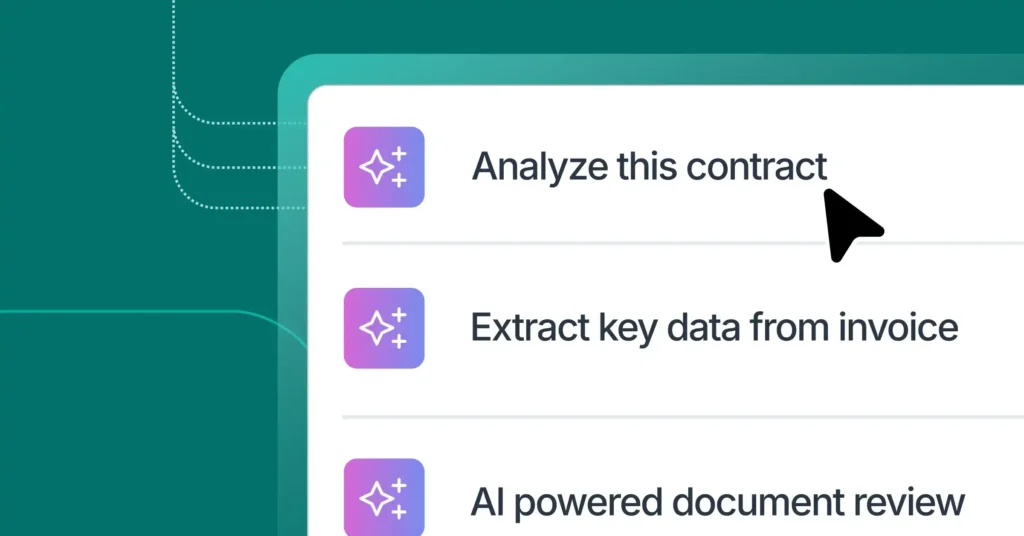The top three generative AI legal use cases for in-house counsel

More than ever before, legal teams are leveraging AI to reduce overheads and position themselves as strategic business partners. But in a crowded marketplace of solutions, which generative AI legal use cases are no-brainers for in-house counsel?
To fulfil our roles as high-performing business partners, it’s critical that in-house legal teams are able to deliver the strategic advice that matters most to our organizations.
However, with 83 percent of in-house legal leaders reporting that manual administrative tasks prevent them from focusing on strategic work, it’s clear that when it comes to inefficient legal workflows, it’s our highest-value work that is suffering the most.
In this article, we introduce the three most reliable AI use cases to help in-house counsel optimize their efficiency, freeing up time to focus on the work that matters most.
Simplicity – not risk
Despite AI fast becoming a must-have weapon against inefficiency across countless industries, the legal profession has remained cautious of the associated risks. However, despite much of the hype surrounding the dangers of generative AI and its potential negative impact on the legal industry, the reality is that, as in-house lawyers, we are only poised to gain.
While there is a vast array of AI tools on the market, not all are made equal. Some advanced legal AI tools are still in their nascency, and carry greater risk. However, when used strategically, there are a number of proven generative AI legal use cases which can transform the low complexity, mundane tasks which weigh down our workflows – without jeopardizing the integrity of our output.
Three proven generative AI legal use cases to try today
By leveraging safe and proven AI use cases which meet the specific needs of your in-house legal function, you can empower your team to level up their efficiency quickly without taking on unnecessary risk.
Here are three high value, reliable ways to get started with this technology in-house.
1. Contract and invoice data extraction
Rather than focusing on using generative AI to create work from scratch, by far the most valuable way to utilize AI within an in-house legal environment is by surfacing and tracking the extensive data which already exists within your workflows.
Gathering and storing data into a comprehensive repository is the first step to understanding what your legal team is working on and where you are spending your budget – and creating a centralized source of truth is critical when preparing your legal team to adopt in-house legal AI.
A lot of your most valuable data in-house will originate from invoices and contracts. Attempting to manually extract data from these documents is a burdensome and time-consuming process – and one which is likely to end up at the bottom of your team’s to-do list.
“Use AI to extract your data into contract or spend management systems (or, even better, into a comprehensive legal workspace such as LawVu) to build up a rich repository.”
AI can help you dramatically improve the level of visibility and control that you have over your contracts and invoices. AI-powered contract extraction tools can identify and extract relevant data from your contracts, reducing the need for manual searches, speeding up review times and reducing the chances of missed deadlines, while AI-powered invoice extraction tools allow you to streamline your legal spend management.
By extracting your data into contract or spend management systems (or, even better, into a comprehensive legal workspace such as LawVu) these tools will enable you to build up a rich repository of data – one which will expedite the process of populating future documents and provide invaluable operational insight across the breadth of your legal work.
2. Contract redlining
Enhance your contract review processes by using AI tools which can analyze contracts, identify clauses, and flag potential risks. Before investing in a redlining tool, it’s worth considering who in your team is spending the most time on contract review – and what would benefit them the most.
If you have a team of senior lawyers working on complex contracts, a tool like Henchman which will simply surface relevant language may help them navigate through a long contract more quickly. However, junior lawyers may benefit more from a tool like Robin AI, which provides guardrails by displaying your playbook as a checklist to work through to ensure nothing is missed.
Contract review tools are typically designed to add most efficiency when you have a high volume of low complexity third party contracts such as NDAs, DPAs or simple MSAs. This is the best place to start. Using a well-established tool like BlackBoiler to redline third party NDAs can significantly reduce the amount of time your team is spending on NDA review, and in time help the wider business self-serve where it makes sense.
3. E-Discovery
Leverage AI for large-scale document review projects and to help you automate the way that you identify and collect data from your systems for compliance purposes. Legal teams have been using technology for many decades to assist with the burdensome and costly task of document review for litigation – so much so that court guidelines now advise on the use of AI for high volume disclosures (TAR).
For any large document review task, it’s worth considering how you (or your outside counsel) could leverage an AI powered review tool to save costs and time. More recently, newer systems such as DISCO and Reveal’s Onna product target the previously costly and cumbersome process of applying an in-place legal hold across systems, collecting data into a centralized system and processing it for review.
Key considerations before you adopt AI
Contract and invoice data extraction, redlining and e-discovery tools are all tried and tested applications for in-house legal AI, and all present a great opportunity to start implementing this technology with relatively little lift.
However, it’s important to remember that generative AI is only ever as powerful as the information which feeds into it – and that even the most reliable use cases need to be grounded in robust and safe systems of work to deliver the most value.
Lay the groundwork
Before adopting any AI tool, it’s critical to prepare your in-house legal team for the transition and position yourself to make the most out of your investment. As part of this process, integration with your existing tech systems should be a key consideration. An AI tool which integrates seamlessly with your legal workspace or CLM will add far more value and be easier for your team to adopt than a solution that is siloed.
Be responsible
The ethical implications of AI remain a topic of hot debate, from questions of bias to transparency concerns. However, for the purposes of in-house counsel, responsible use of AI effectively means ticking two boxes. Firstly, it means choosing reputable AI vendors who can demonstrate robust and secure systems which are legally compliant, protect data and minimize risk. Secondly, it means ensuring responsible user deployment within your legal team itself.
Avoid over-reliance
To ground your AI investment decisions in reality, assess your potential ROI by comparing the human effort currently required to complete a given task (such as contract review) versus that involved when using AI-powered technology – including any time that you may need to spend monitoring AI output as a “human in the loop”.
It’s also critical to weigh the benefits of any given AI tool against the potential drawbacks. This can be a balancing act – for some tools, the benefits (such as quicker contract turnaround time or less distractions) may clearly outweigh the drawbacks (less oversight, higher risk tolerance on low risk tasks) but for others, mitigating the downsides may be a heavier lift.
Select tools that are user-friendly and can adapt to the evolving needs of your legal team, and which enhance your existing operations rather than offering AI for the sake of it.
Ready to take the next step?
By strategically adopting safe and reliable generative AI legal use cases, you will enhance the operational efficiency of your in-house function while strengthening your role as an indispensable strategic advisor.
If you’re ready to try out a proven use case for AI, adopting a consolidated solution designed specifically for in-house legal teams, such as the LawVu legal workspace, can set you up with the foundations to maximize the value that you extract from AI over the long term.
To learn more about how a workspace approach to AI could transform the efficiency and output of your legal function, book a demo now.
It's time to move on AI
